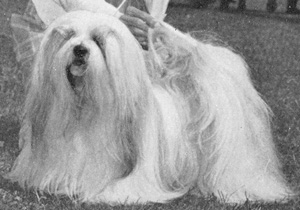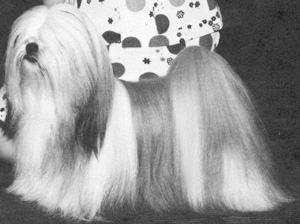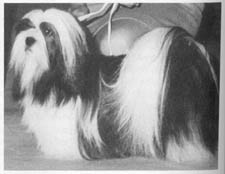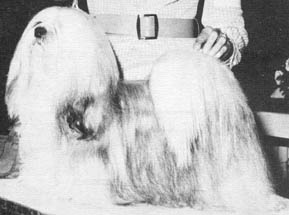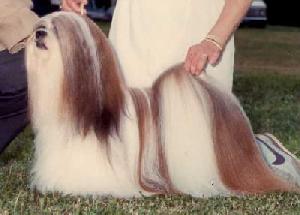|
GR - Georgia Roberts
JR - James Roberts
How and when did you get started in Lhasas?
GR - Oh my, thats a long story! Mrs. Ritchie
from Vancouver bought two Lhasas in 1953 bred by Mrs. Haas in Toronto.
The male, Karandale Dakmar, finished his American championship, and the
little bitch - we called her "Goldie", was Can. Ch. Karandale
Tangee. She had three puppies in January 1954 and Mrs. Ritchie
brought them out to board with us when they were only a few weeks old.
I had never seen one before - had heard of them but that was it.
There were none out here. There was a lady on Vancouver Island who
had some that she showed in obedience and did very well with them.
She was married to a sailor and he was transferred to Nova Scotia and
that was the end of her. But we had these three puppies and Goldie
to board and we fell in love with them, absolutely! I bought one
of them, a little female named "Ping" for Jim for Father's
Day. Later on, when Ping was around two, I took her to California
and bred her to one of Mrs. Liebman's dogs, Ch. Ming Tali 11, CD.
She had three puppies and one of those, a female, we sold to Marianne
Nixon guaranteeing that she would be a good show dog. She was -
Marianne even got a group with her which was unheard of for a Lhasa.
To this day, Marianne says she was the best Lhasa she ever had.
She was Ch. Jo-Mo Dkar-Po of Abbotsford.
Were Lhasas your first breed?
GR - No, English Cockers were the first. We
showed our first one in 1940.
And then Poodles?
GR - And then Poodles. The same Mrs. Ritchie
had Poodles, and Mrs. Melchers also had them - she had a lot of English
imports and did wonderfully well with them. I used to board their
dogs and look after Mrs. Melchers' when she was away. They were
all show dogs and I had to groom them. After a gear I gave in and
they gave me one, a miniature. When I first saw Poodles I
thought they were the silliest things I had ever seen, having been used
to sporting dogs. We brought quite a few out from England at
different times.
We had the Poodles the tail-end of the Cockers, but I had to quit
showing Cockers because my heart was bad and I couldn't go galloping
around the Sporting Group ring, so the Miniature Poodles were more my
size. Then of course, everybody and his aunt had Poodles - they
were a status quo. They paid no attention to rhyme nor reason - no
color, no bloodlines, no nothing! They made such a mess of the
Poodles. Of course the prices went down and then all the
fly-by-night people quit. But in the meantime, I was so disgusted
that I quit. I wouldn't have anything more to do with them because
were breeding good stock and it was so sickening to see this happen.
JR - The American Cockers went through the same
thing, but the Cocker is a nice dog today.
GR - Anyway, then we concentrated on nothing but
Lhasas.
Has your husband always shared your interest in the Lhasas?
GR - Oh, good gracious yes!
JR - It was I who started it because I was crazy
about them!
GR - Then he had the butcher shop which made getting
meat for them a cinch.
JR - I was the one who brought all the dogs from
England.
GR - He was the one who had the eye for a dog,
knowing the anatomy of animals - all animals.
What has been your goal in breeding?
GR - Better - always something better. Always
looking to improve both the disposition and the quality.
Do you feel that you have achieved your goal?
GR - With Teako, yes. But he was one in a
lifetime. We don't expect to ever get another one.
What was Teako like?
GR - From the time he was six weeks old you couldn't
miss him. He was the one that we both agreed upon right from the
start.
JR - He was perfection plus.
GR - Look at his picture when he was ten weeks old -
you can see it right there.
JR - He projected himself, Nelson ( Teako's sire,
Brackenbury Kandron) did the same thing. They gave something that
siad, "Here I am, look at me!" - CLASS! You can have a
magnificent dog and if it doesn't project itself its just
"blah" in the ring.
What was your greatest thrill in showing Teako?
GR - I think winning the Specialty in Beverly Hills.
There were 79 Lhasas and 16 Specials, not counting him, and he took
second in the Group besides that day! There were 3,500 dogs in the show.
The position of Top Lhasa in Canada has been held ten times
by Abbotsford dogs and the second and third position several times as
well. To what do you attribute your consistent success in breeding
top dogs?
GR - Just trial and error. Paying attention to
the bloodlines and to the individual dog, what it needs. I like
the combination of grandfather to granddaughter very much.
JR - Helping Mother Nature. Inbreeding,
especially in Lhasa Apsos, as long as the dogs are good. Thats the
only way we've been able to do it, because we found it impossible
sometimes to find a dog to bring in.
Would you give a brief word picture of your idea of the ideal
Lhasa Apso?
JR - Never over 10 inches at the shoulder - 10, 10
1/4 inches. At 10 1/2 inches you are getting too bit. The
ideal is a compact little dog that projects himself. Nice neck,
solid - personality and projection.
GR - Good muscle and bone and a head that measures
properly. A level toplind and a tail that lies flat on the back.
One that moves right fore and aft. But the idea of the straight
front legs - they should Not be like a Terrier. They should have
that little bend at the pastern that gives them what Jim calls
"four-wheel suspension". Otherwise, if they are built
like a Wire-Haired Fox Terrier, how can they climb the mountains in the
terrain of Tibet?
JR - they have a fluid motion. They should be
built like a Greed Goddess with the rear-end of an Irish washerwoman!
GR - I think Jim's description has always been
correct - and a face like an old tomcat!
JR - Ten inches tall, 17 - 18 pounds, depending on
the dog.
GR - I would stress the size, I really would,
because - you take these big dogs that they have now ...
JR - They're not Lhasas!
GR - No, they're not! Twelve inches is too
large. They don't look like Lhasas ... just big cumbersome dogs!
JR - I've talked with Tibetan people at the
University of Washington and they informed their dogs are small and all
matts!
How do you feel about the overall quality of the Lhasa Apso
as a breed?
GR - Oh, I think they have come a long way.
When I think back to when I first started, people didn't know how to
groom them - they had beat-up coats. The idea that everything
should be golden has gone by the board. If it is a good dog, color
shouldn't matter.
JR - We never bred for color.
What about pigment?
GR - Oh yes. They must have good dark
pigmentation whatever color they are.
Have you noticed any specific faults you feel Lhasa breeders
should be especially aware of and concentrate on trying to improve?
GR - Yes, size.
JR - They should concentrate on mouth. They
are letting too many go with overbites.
Of how much importance to you is the Lhasa bite?
GR - If you have a dog that is good every other way,
unless it is pronounced overshot, I wouldn't ditch a really good
specimen for something like that.
JR - You are supposed to have a correct mouth, but
if you have to get 100% perfection, you'll never breed!
What about coat type?
GR - Profuse all over, straight, not curly, not fuzzy. They are
supposed to have an undercoat - all mine do. They should have a
dense coat, and long, reasonably coarse on the outside, bit it is soft
underneath. The hair on their legs and chest is soft.
JR - Firm, profuse, straight. They have to have and undercoat -
remember that they come from a very cruel country, the weather in winter
is terrible. Not fine, no wire - no Afro!
Anything else that you would like to mention?
GR - Yes, disposition. This "chary of
strangers" is fine, but they should not bite. You couldn't
make one of our Lhasas bite - not one in the whole 27 years. But
they are marvelous little watchdogs. They will scare the devil out
of anybody who comes banging on the door or somebody thay they don't
know, but no way would they bite. That is something in the ring.
If one bit the judge for any ordinary reason, out he should go!
JR - And if he is "chary" as they say,
then he doesn't show. You've got to have a dog thats biddable and
disciplined.
GR - I would forgive that to a certain extent,
because some of them dislike certain people, but if they'd bite, out
they would go.
JR - We always think a Lhasa likes children first,
women second, and men last!
|

